Potential Impacts of Climate Change on Extreme Weather Events in the Niger Delta Part of Nigeria
Abstract
:1. Introduction
2. Description of the Study Area
3. Materials and Methods
3.1. Meteorological Datasets
3.2. Coupled Model Inter-Comparison Project Phase 5 (CMIP5) General Circulation Models (GCM) Datasets
3.3. Bias Correction
3.4. Meteorological Drought Assessment
3.5. Performance Assessment of the Models
4. Results and Discussion
4.1. Performance Assessment of GCM Ensemble
4.2. Observed and Predicted Rainfall Scenarios
4.3. Meteorological Drought Assessment
5. Discussion
Adaptation and Planning Strategy
6. Conclusions
Author Contributions
Funding
Conflicts of Interest
References
- Worku, L.Y. Climate change impact on variability of rainfall intensity in the Upper Blue Nile Basin. Proc. Int. Assoc. Hydrol. Sci. 2015, 366, 135–136. [Google Scholar] [CrossRef] [Green Version]
- IPCC. Mitigation of Climate Change: Contribution of Working Group III to the Fourth Assessment Report of the Intergovernmental Panel on Climate Change; Cambridge University Press: Cambridge, UK; New York, NY, USA, 2007; pp. 226–230. [Google Scholar]
- Chen, X.; Li, X.; Yuan, X.; Zeng, G.; Liang, J.; Li, X.; Xu, W.; Luo, Y.; Chen, G. Effects of human activities and climate change on the reduction of visibility in Beijing over the past 36 years. Environ. Int. 2018, 116, 92–100. [Google Scholar] [CrossRef]
- Li, X.; Chen, X.; Yuan, X.; Zeng, G.; León, T.; Liang, J.; Chen, G.; Yuan, X. Characteristics of particulate pollution (PM2.5 and PM10) and their spacescale-dependent relationships with meteorological elements in China. Sustainability 2017, 9, 2330. [Google Scholar] [CrossRef] [Green Version]
- IPCC. Climate Change 2007 Synthesis Report; Synthesis Report. Contribution of Working Groups I, II and III to the Fourth Assessment Report of the Intergovernmental Panel on Climate Change; IPCC: Geneva, Switzerland, 2007; p. 104. [Google Scholar]
- Seiler, R.A.; Hayes, M.; Bressan, L. Using the standardized precipitation index for flood risk monitoring. Int. J. Climatol. 2002, 22, 1365–1376. [Google Scholar] [CrossRef]
- Ranger, N.; Hallegatte, S.; Bhattacharya, S.; Bachu, M.; Priya, S.; Dhore, K.; Rafique, F.; Mathur, P.; Naville, N.; Henriet, F.; et al. An assessment of the potential impact of climate change on flood risk in Mumbai. Clim. Chang. 2011, 104, 139–167. [Google Scholar] [CrossRef] [Green Version]
- Cirella, G.T.; Iyalomhe, F.O. Flooding conceptual review: Sustainability-focalized best practices in Nigeria. Appl. Sci. 2018, 8, 1558. [Google Scholar] [CrossRef] [Green Version]
- Etuonovbe, A.K. The Devastating Effect of Flooding in Nigeria. J. Hydrogr. Environ. 2011, 18–22. [Google Scholar]
- UNOCHA. Humanitarian Bulletin Nigeria; United Nations Office for the Coordination of Humanitarian Affairs: Abuja, Nigeria, 2015; Available online: https://www.unocha.org/story/niger-heavy-rains-and-floods-force-more-400000-people-their-homes (accessed on 12 November 2019).
- Oluwaseyi, A. Plant Genetic Resources (PGR) in Nigeria and the Reality of Climate Change—A Review. Asian J. Environ. Ecol. 2017, 2, 1–24. [Google Scholar] [CrossRef]
- Brown, I.; Chikagbum, W. Planning response to water related disasters in Nigeria the Rivers state experience. Int. J. Sci. Eng. Res. 2015, 6, 32–44. [Google Scholar]
- Mmom, P.C.; Aifesehi, P.E. Vulnerability and Resilience of Niger Delta Coastal Communities to Flooding. IOSR J. Humanit. Soc. Sci. 2013, 10, 27–33. [Google Scholar] [CrossRef]
- Hazards, N.; Education, W.; Education, W. The Niger Delta’ s vulnerability to river floods due to sea level rise. Nat. Hazards Earth Syst. Sci. 2014, 14, 3317–3329. [Google Scholar]
- Amangabara, G.T.; Gobo, A.E. Factors that influence the flooding of the middle and lower Ntamogba stream catchments, Port Harcourt, Nigeria. J. Environ. Hydrol. 2007, 15, 1–11. [Google Scholar]
- Amangabara, G.; Obenade, M. Flood Vulnerability Assessment of Niger Delta States Relative to 2012 Flood Disaster in Nigeria. Am. J. Environ. Prot. 2015, 3, 76–83. [Google Scholar]
- Ologunorisa, T.E.; Adeyemo, A. Public perception of flood hazard in the Niger Delta, Nigeria. Environmentalist 2005, 25, 39–45. [Google Scholar] [CrossRef]
- Tawari-fufeyin, P.; Paul, M.; Godleads, A.O. Some Aspects of a Historic Flooding in Nigeria and Its Effects on some Niger-Delta Communities. Am. J. Water Resour. 2015, 3, 7–16. [Google Scholar]
- Mckee, T.B.; Doesken, N.J.; Kleist, J. The relationship of drought frequency and duration to time scales. In Proceedings of the Eighth Conference on Applied Climatology, Anaheim, CA, USA, 17–22 January 1993. [Google Scholar]
- Mckee, T.B.; Doesken, N.J.; Kleist, J. Drought Monitoring with Multiple Time Scales. In Proceedings of the 9th Conference on Applied Climatology, Dallas, TX, USA, 15–20 January 1995. [Google Scholar]
- Komuscu, A.U. Using the SPI to Analyze Spatial and Temporal Patterns of Drought in Turkey Using the SPI to Analyze Spatial and Temporal Patterns of Drought in Turkey. Drought Netw. News 1999, 11, 6–13. [Google Scholar]
- Svoboda, M.; Hayes, M.; Wood, D. Standradized Precipitation Index User Guide. World Meteorol. Organ. 2012, 21, 1333–1348. [Google Scholar]
- Shahid, S. Spatial and temporal characteristics of droughts in the western part of Bangladesh. Hydrol. Process. Wiley Intersci. 2008, 2274, 2267–2274. [Google Scholar]
- IPCC. Climate Change: The IPCC Scientific Assessment; Cambridge University Press: Cambridge, UK, 1990; Volume 1, p. 414. [Google Scholar]
- IPCC. Climate Change 2007: Impacts, Adaptation and Vulnerability: Contribution of Working Group II to the Fourth Assessment Report of the Intergovernmental Panel on Climate Change; Cambridge University Press: Cambridge, UK, 2007; p. 976. [Google Scholar]
- Matemilola, S.; Adedeji, O.H.; Elegbede, I.; Kies, F. Mainstreaming climate change into the EIA process in Nigeria: Perspectives from projects in the Niger Delta Region. Climate 2019, 7, 29. [Google Scholar] [CrossRef] [Green Version]
- Amadi, A.N. Impact of Gas-Flaring on the Quality of Rain Water, Groundwater and Surface Water in Parts of Eastern Niger Delta, Nigeria. J. Geosci. Geomat. 2014, 2, 114–119. [Google Scholar]
- Adejuwon, J.O. Rainfall seasonality in the Niger Delta Belt, Nigeria. J. Geogr. Reg. Plan. 2012, 5, 51–60. [Google Scholar]
- Ologunorisa, T.E.; Tersoo, T. The changing rainfall pattern and its implication for flood frequency in Makurdi, Northern Nigeria. J. Appl. Sci. Environ. Manag. 2006, 10, 97–102. [Google Scholar] [CrossRef] [Green Version]
- Ituen, E.U.; Alonge, A.F. Niger Delta Region of Nigeria, Climate Change and the way Forward. In Proceedings of the Bioenergy Engineering, Washington, DC, USA, 11–14 October 2009. [Google Scholar]
- Harris, I.; Jones, P.D.; Osborn, T.J.; Lister, D.H. Updated high-resolution grids of monthly climatic observations—The CRU TS3.10 Dataset. Int. J. Climatol. 2014, 34, 623–642. [Google Scholar] [CrossRef] [Green Version]
- Jones, P.D.; Harris, I.C. Climatic Research Unit (CRU) Time-Series Datasets of Variations in Climate with Variations in Other Phenomena. NCAS British Atmospheric Data Centre; University of East Anglia: Norwich, UK, 2008; Available online: http://catalogue.ceda.ac.uk/uuid/3f8944800cc48e1cbc29a5ee12d8542d (accessed on 13 June 2017).
- Ashraf Vaghefi, S.; Abbaspour, N.; Kamali, B.; Abbaspour, K.C. A toolkit for climate change analysis and pattern recognition for extreme weather conditions—Case study: California-Baja California Peninsula. Environ. Model. Softw. 2017, 96, 181–198. [Google Scholar] [CrossRef]
- Hassan, I.; Kalin, R.M.; White, C.J.; Aladejana, J.A. Evaluation of Daily Gridded Meteorological Datasets over the Niger Delta Region of Nigeria and Implication to Water Resources Management. Atmos. Clim. Sci. 2020, 10, 21–39. [Google Scholar] [CrossRef] [Green Version]
- Hassan, I.; Kalin, R.M.; White, C.J.; Aladejana, J.A. Selection of CMIP5 GCM ensemble for the projection of Spatio-temporal changes in precipitation and temperature over the Niger Delta, Nigeria. Water 2020, 12, 385. [Google Scholar] [CrossRef] [Green Version]
- Wang, L.; Ranasinghe, R.; Maskey, S.; van Gelder, P.H.A.J.M.; Vrijling, J.K. Comparison of empirical statistical methods for downscaling daily climate projections from CMIP5 GCMs: A case study of the Huai River Basin, China. Int. J. Climatol. 2016, 36, 145–164. [Google Scholar] [CrossRef]
- Teutschbein, C.; Seibert, J. Bias correction of regional climate model simulations for hydrological climate-change impact studies: Review and evaluation of different methods. J. Hydrol. 2012, 456–457, 12–29. [Google Scholar] [CrossRef]
- Mehrotra, R.; Sharma, A. Correcting for systematic biases in multiple raw GCM variables across a range of timescales. J. Hydrol. 2015, 520, 214–223. [Google Scholar] [CrossRef]
- Beyer, R.; Krapp, M.; Manica, A. A systematic comparison of bias correction methods for paleoclimate simulations. Clim. Past Discuss. 2019, 11, 1–23. [Google Scholar]
- Xu, Y. Hydrology and Climate Forecasting R Package for Data Analysis and Visualization 2018. Available online: https://cran.r-project.org/web/packages/hyfo/hyfo.pdf (accessed on 12 October 2019).
- Lloyd-Hughes, B.; Saunders, M.A. A drought climatology for Europe. Int. J. Climatol. 2002, 22, 1571–1592. [Google Scholar] [CrossRef]
- Neves, J. Package ‘Spi’: Compute SPI Index. 2015. Available online: https://cran.r-project.org/web/packages/spi/spi.pdf (accessed on 20 October 2019).
- Willmott, C.J. On the validation of models. Phys. Geogr. 1981, 2, 184–194. [Google Scholar] [CrossRef]
- Moriasi, D.N.; Arnold, J.G.; Liew, M.W.; Van Bingner, R.L.; Harmel, R.D.; Veith, T.L. Model Evaluation Guidelines for Systematic Quantification of Accuracy in Watershed Simulations. Am. Soc. Agric. Biol. Eng. 2007, 50, 885–900. [Google Scholar]
- Moriasi, D.; Arnold, J.; Liew, M.W.V. Model Evaluation Guidelines for Systematic Quantification of Accuracy in Watershed Simulations. Available online: https://www.researchgate.net/publication/43261199_Model_Evaluation_Guidelines_for_Systematic_Quantification_of_Accuracy_in_Watershed_Simulations (accessed on 12 January 2020).
- Krinner, G.; Germany, F.; Shongwe, M.; Africa, S.; France, S.B.; Uk, B.B.B.B.; Germany, V.B.; Uk, O.B.; France, C.B.; Uk, R.C.; et al. Long-Term Climate Change: Projections, Commitments and Irreversibility. Available online: https://www.ipcc.ch/site/assets/uploads/2018/02/WG1AR5_Chapter12_FINAL.pdf (accessed on 20 Noveber 2019).
- Expósito, F.J.; González, A.; Pérez, J.C.; Díaz, J.P.; Taima, D. High-resolution future projections of temperature and precipitation in the Canary Islands. J. Clim. 2015, 28, 7846–7856. [Google Scholar] [CrossRef]
- Rangwala, I.; Miller, J.R. Climate change in mountains: A review of elevation-dependent warming and its possible causes. Clim. Chang. 2012, 114, 527–547. [Google Scholar] [CrossRef]
- Martín, J.L.; Bethencourt, J.; Cuevas-Agulló, E. Assessment of global warming on the island of Tenerife, Canary Islands (Spain). Trends in minimum, maximum and mean temperatures since 1944. Clim. Chang. 2012, 114, 343–355. [Google Scholar] [CrossRef]
- Agumagu, O.; Todd, M. Modelling the Climatic Variability in the Niger Delta Region : Influence of Climate Change on Hydrology. Earth Sci. Clim. Chang. 2015, 6, 1–7. [Google Scholar]
- Obroma Agumagu, O.A. Projected Changes in the Physical Climate of the Niger Delta Region of Nigeria. Available online: https://www.semanticscholar.org/paper/Projected-Changes-in-the-Physical-Climate-of-the-of-Agumagu-Agumagu/c5e717ebcd21acd09109553f3c11804f94ece611 (accessed on 13 Noveber 2019).
- Ike, P.C.; Emaziye, P.O. An Assessment of the Trend and Projected Future Values of Climatic Variables in Niger Delta Region, Nigeria. Available online: https://www.researchgate.net/publication/268202347_An_Assessment_of_the_Trend_and_Projected_Future_Values_of_Climatic_Variables_in_Niger_Delta_Region_Nigeria (accessed on 28 Noveber 2019).
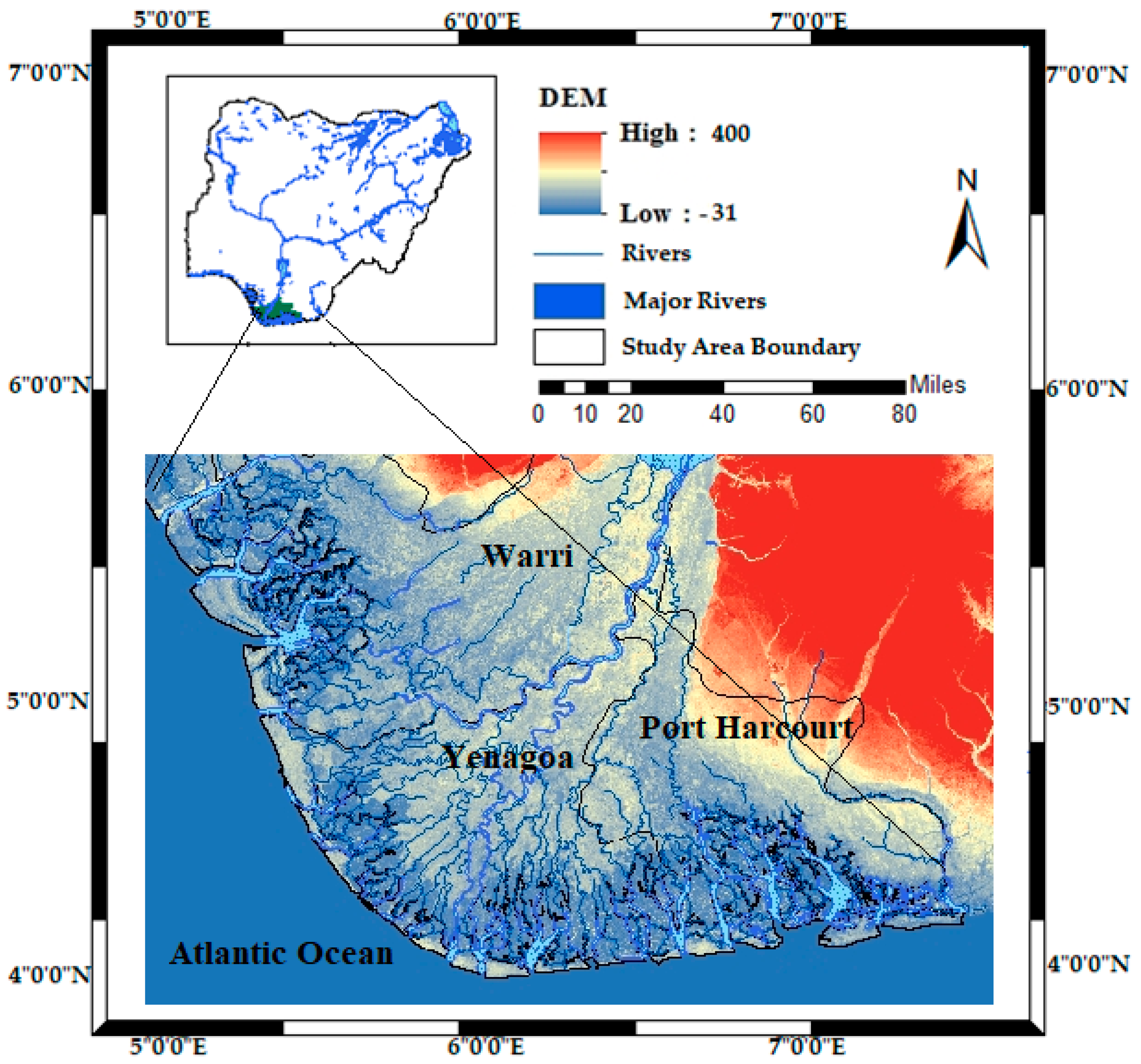
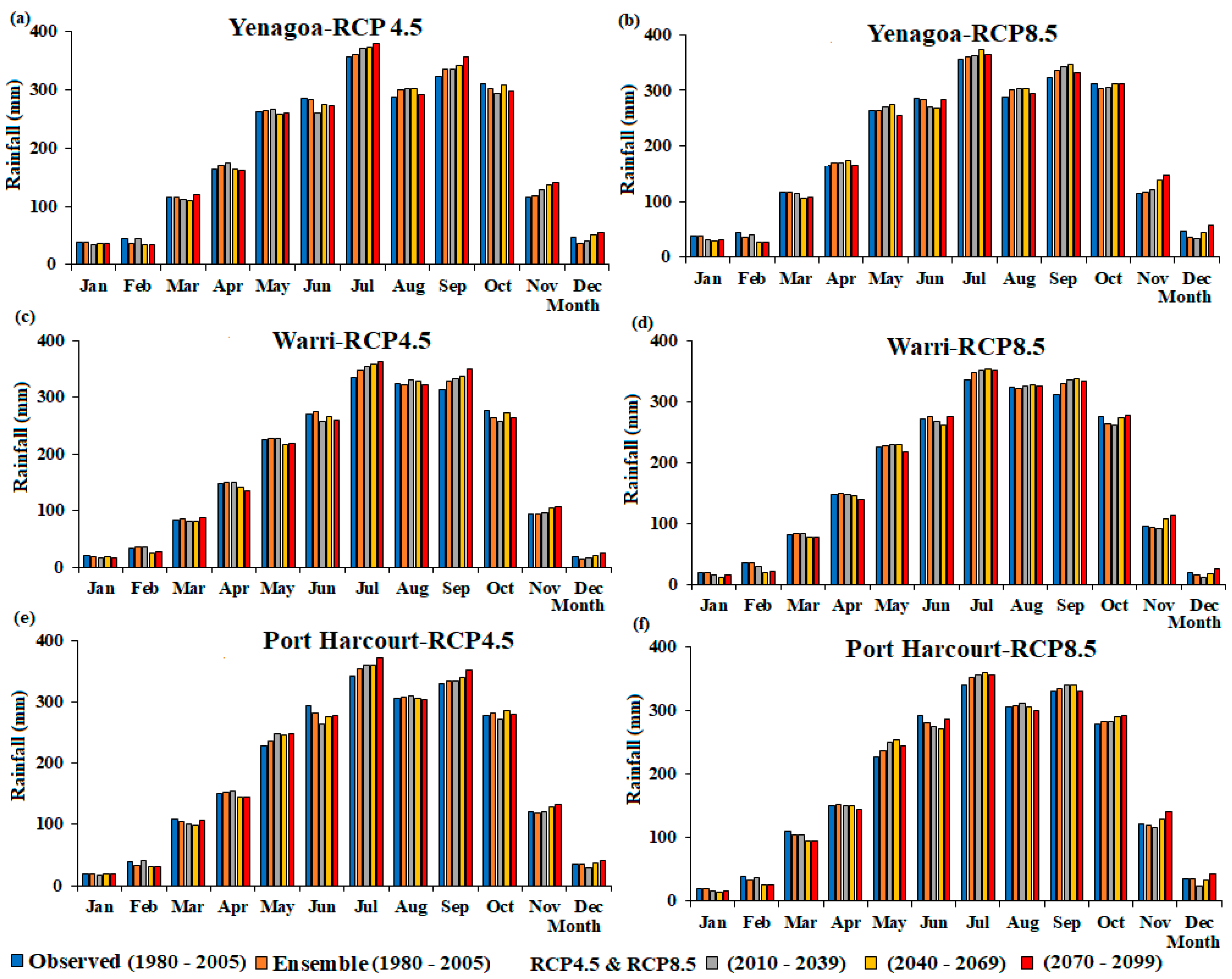
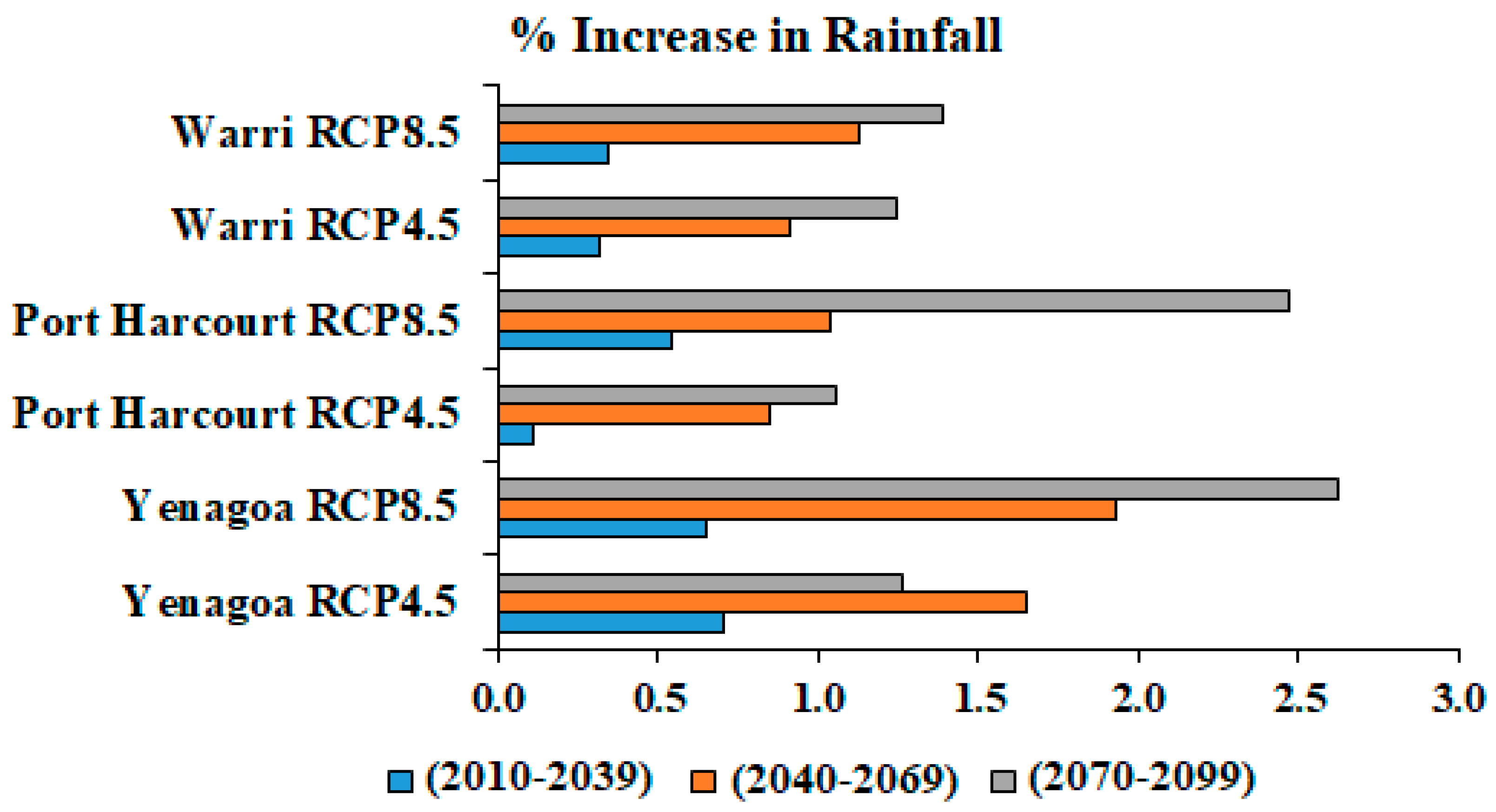

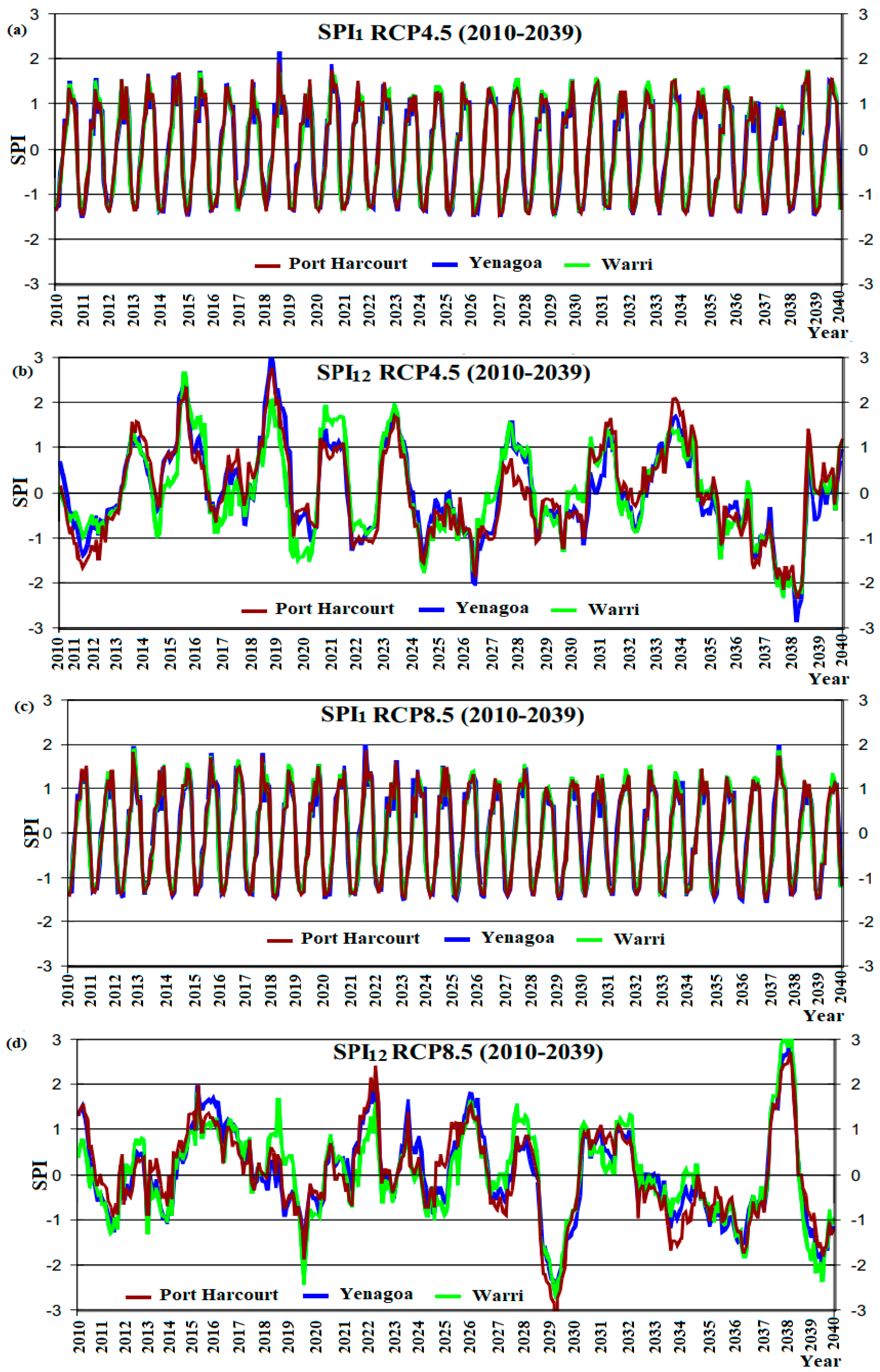
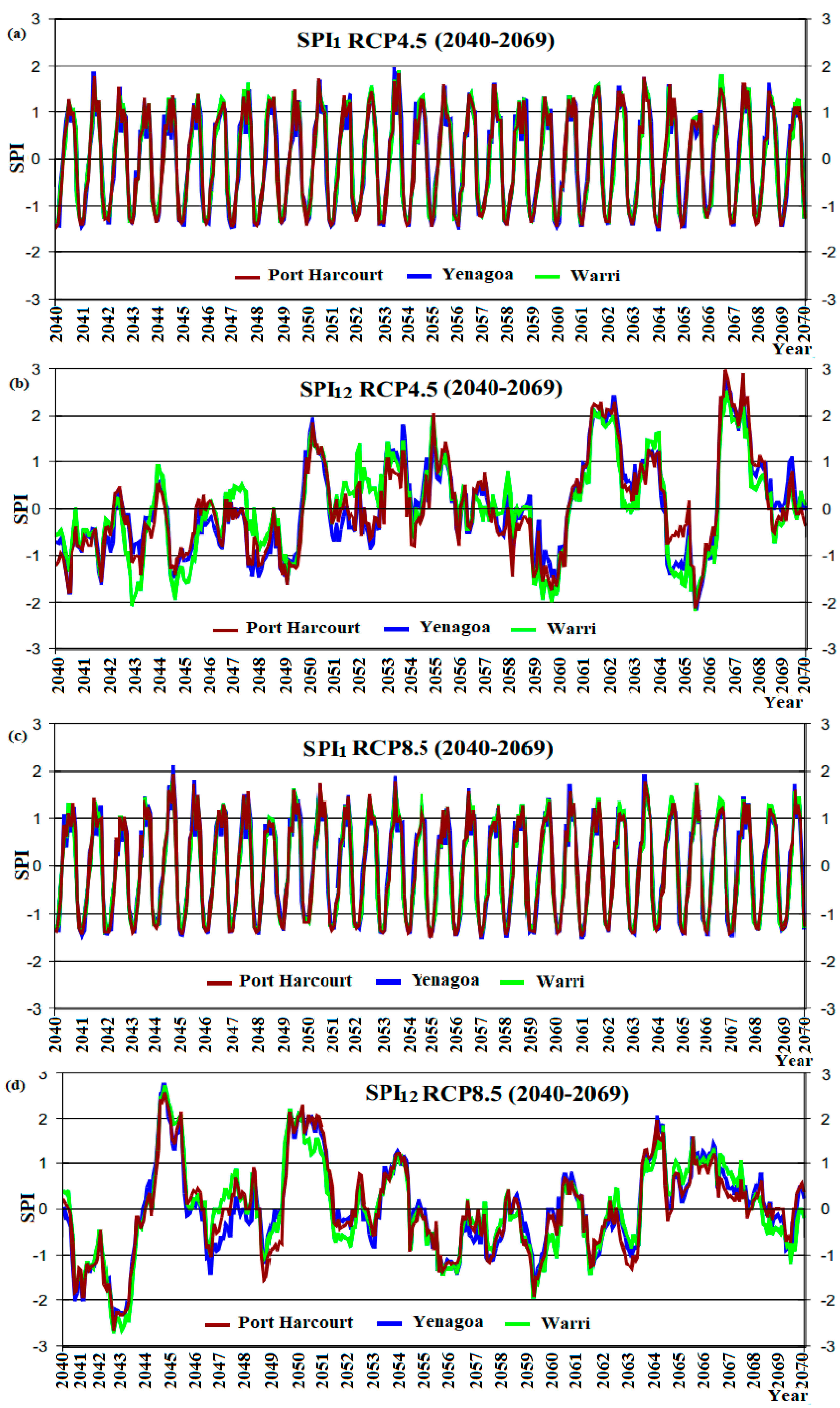
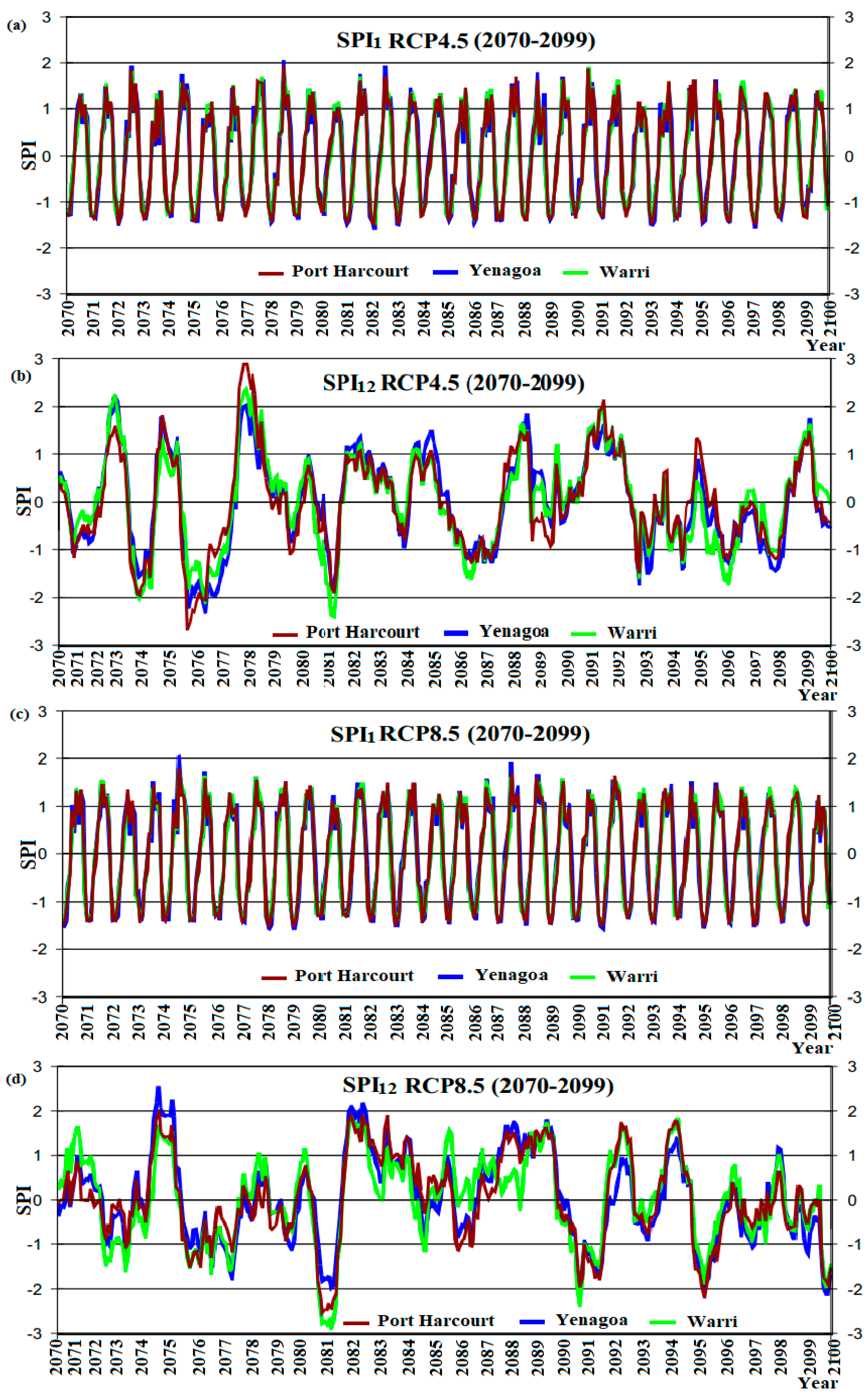
| Models | Institute |
|---|---|
| ACCESS1-3 | CSIRO (Commonwealth Scientific & Industrial Research Organization, Australia), and BOM (Bureau of Meteorology, Australia) |
| MIROC-ESM | AORI, NIES and JAMSTEC |
| MIROC-ESM-CHEM | AORI, NIES and JAMSTEC |
| NoerESM1-M | Norwegian Climate Centre |
| Drought Category | SPI Value |
|---|---|
| Extremely wet | 2.00+ |
| Very wet | 1.50 to 1.99 |
| Moderately wet | 1.00 to 1.49 |
| Near normal | −0.99 to 0.99 |
| Moderately dry | −1.00 to −1.49 |
| Severely dry | −1.50 to −1.99 |
| Extremely dry | −2.00 and less |
| Location | RMSE | NSE | R2 |
|---|---|---|---|
| Port Harcourt | 78.49 | 0.59 | 0.84 |
| Yenagoa | 62.29 | 0.74 | 0.92 |
| Warri | 75.54 | 0.64 | 0.85 |
© 2020 by the authors. Licensee MDPI, Basel, Switzerland. This article is an open access article distributed under the terms and conditions of the Creative Commons Attribution (CC BY) license (http://creativecommons.org/licenses/by/4.0/).
Share and Cite
Hassan, I.; Kalin, R.M.; Aladejana, J.A.; White, C.J. Potential Impacts of Climate Change on Extreme Weather Events in the Niger Delta Part of Nigeria. Hydrology 2020, 7, 19. https://doi.org/10.3390/hydrology7010019
Hassan I, Kalin RM, Aladejana JA, White CJ. Potential Impacts of Climate Change on Extreme Weather Events in the Niger Delta Part of Nigeria. Hydrology. 2020; 7(1):19. https://doi.org/10.3390/hydrology7010019
Chicago/Turabian StyleHassan, Ibrahim, Robert M. Kalin, Jamiu A. Aladejana, and Christopher J. White. 2020. "Potential Impacts of Climate Change on Extreme Weather Events in the Niger Delta Part of Nigeria" Hydrology 7, no. 1: 19. https://doi.org/10.3390/hydrology7010019






